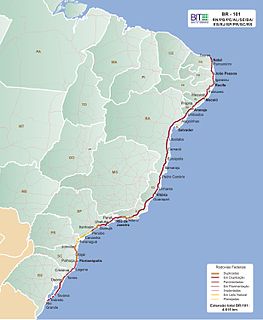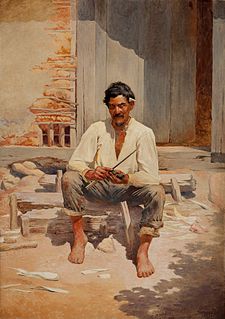
Paraná is one of the 26 states of Brazil, in the south of the country, bordered on the north by São Paulo state, on the east by the Atlantic Ocean, on the south by Santa Catarina state and the province of Misiones, Argentina, and on the west by Mato Grosso do Sul and Paraguay, with the Paraná River as its western boundary line. It is subdivided into 399 municipalities, and its capital is the city of Curitiba. Other major cities are Londrina, Maringá, Ponta Grossa, Cascavel, São José dos Pinhais and Foz do Iguaçu. The state is home to 5.4% of the Brazilian population and has 6.2% of the Brazilian GDP.

Mato Grosso do Sul is one of the Midwestern states of Brazil. Neighboring Brazilian states are Mato Grosso, Goiás, Minas Gerais, São Paulo and Paraná. It also borders the countries of Paraguay, to the southwest, and Bolivia, to the west. The economy of the state is largely based on agriculture and cattle-raising. Crossed in the south by the Tropic of Capricorn, Mato Grosso do Sul generally has a warm, sometimes hot, and humid climate, and is crossed by numerous tributaries of the Paraná River. The state has 1.3% of the Brazilian population and is responsible for 1.5% of the Brazilian GDP.

Rio Grande do Sul is a state in the southern region of Brazil. It is the fifth-most-populous state and the ninth largest by area. Located in the southernmost part of the country, Rio Grande do Sul is bordered clockwise by Santa Catarina to the north and northeast, the Atlantic Ocean to the east, the Uruguayan departments of Rocha, Treinta y Tres, Cerro Largo, Rivera and Artigas to the south and southwest, and the Argentine provinces of Corrientes and Misiones to the west and northwest. The capital and largest city is Porto Alegre. The state has the highest life expectancy in Brazil, and the crime rate is relatively low compared to the Brazilian national average. Despite the high standard of living, unemployment is still high in the state, as of 2017. The state has 5.4% of the Brazilian population and it is responsible for 6.6% of the Brazilian GDP.

The South Region of Brazil is one of the five regions of Brazil. It includes the states of Paraná, Rio Grande do Sul, and Santa Catarina, and covers 576,409.6 square kilometres (222,553.0 sq mi), being the smallest region of the country, occupying only about 6.76% of the territory of Brazil. Its whole area is smaller than that of the state of Minas Gerais, in Southeast Brazil, for example.

The BR-101 is a longitudinal highway of Brazil. It is the longest in the country with a length of nearly 4,800 km (3,000 mi), and it is considered one of the most important highways in the country, along with BR-116.

A Caipira is an ethnic group native to Paulistânia, cultural area in Brazil, the term "caipira", of origin in the Paulista General language, probably influenced by the terms "kai'pira", "ka'apir", "ka'a pora" or "kopira", from the Tupi language, originally designates, since Brazilian colonial times, the inhabitant of the countryside, the "bush cutter". The caipira reached, mainly, due to the cycle of bandeirism and tropeirism, populations of the former Captaincy of São Vicente, which today are the states of Santa Catarina, Paraná, São Paulo, Mato Grosso do Sul, Minas Gerais, Goiás, Mato Grosso, Tocantins, Rondônia and Rio Grande do Sul, as well as parts of south of Rio de Janeiro state, such as Paraty, which was part of São Paulo until 1727 and parts of Uruguay that were disputed with Spain.

The agriculture of Brazil is historically one of the principal bases of Brazil's economy. While its initial focus was on sugarcane, Brazil eventually became the world's largest exporter of coffee, soybeans, beef, and crop-based ethanol.

Tourism in Brazil is a growing sector and key to the economy of several regions of Brazil. The country had 6.589 million visitors in 2018, ranking in terms of the international tourist arrivals as the second main destination in South America after Argentina and third in Latin America after Mexico and Argentina. Revenues from international tourists reached US$5.8 billion in 2015, continuing a recovery trend from the 2008–2009 economic crisis.
Gangamopteris is a genus of Carboniferous-Permian plants, very similar to Glossopteris. Previously, it was classified as fern with reproduction by seed. The genus is usually only applied to leaves, making it a form taxon. Gangamopteris dominates some coal deposits, such as those of the Beacon Supergroup.

The Paraná Basin is a large cratonic sedimentary basin situated in the central-eastern part of South America. About 75% of its areal distribution occurs in Brazil, from Mato Grosso to Rio Grande do Sul states. The remainder area is distributed in eastern Paraguay, northeastern Argentina and northern Uruguay. The shape of the depression is roughly elliptical and covers an area of about 1,500,000 km2 (580,000 sq mi).

The 2009 swine flu pandemic in Brazil began on April 25, 2009, with two people, spreading to 34 over the first two weeks. CDC calculate that Africa and Southeast Asia, which have 38% of the world's population, accounted for a disproportionate 51% of the deaths.

Carambeí is a municipality in the state of Paraná in the Southern Region of Brazil. The city originated from a farm that was an obligatory stop on the Caminho do Viamão between the central-west region of Rio Grande do Sul and the state of São Paulo.It was founded on April 4, 1911 by a group of Dutch immigrants and developed from the Cooperativa Batavo.
Rio Bonito do Iguaçu is a municipality in the state of Paraná in the Southern Region of Brazil.
Rio Branco do Sul is a municipality in the state of Paraná in the Southern Region of Brazil.

Pontal do Paraná is a municipality in the state of Paraná in the Southern Region of Brazil.
The Rio Bonito Formation is a geological formation of the Paraná and Pelotas Basins of Permian age. It is represented by a succession of cyclic sedimentary packages of sandstones, siltstones and shales which bear extensive deposits of coal that has been extracted since the 19th century. The Rio Bonito Formation was deposited in a coastal environment, formed by rivers, deltas, bays and estuaries with tidal plains, barrier islands and shallow marine platform, at a time when the Paraná Basin was a large gulf of the ancient supercontinent Gondwana. This gulf was open to the southwest, to the old ocean Panthalassa. The Rio Bonito Formation outcrops occur mainly in the eastern border of the Paraná Basin, in a narrow band in the states of São Paulo, Paraná, Santa Catarina, Rio Grande do Sul and Uruguay. The Rio Bonito Formation belongs to the second-order stratigraphic supersequence called Gondwana I.
Quadrisporites is an extinct genus of acritarchs. The species Q. horridus was located in outcrop Morro do Papaléo in the town of Mariana Pimentel in Brazil, the geopark Paleorrota. The outcrop is in the Rio Bonito Formation and date of Sakmarian in the Permian.
Capão Bonito do Sul is a municipality in the state of Rio Grande do Sul in the Southern Region of Brazil.
The 2019 Copa do Brasil first stage was the first stage of the 2019 Copa do Brasil football competition. It was played from 5 February to 3 April 2019. A total of 80 teams competed in the first stage to decide 40 places in the second stage of the 2019 Copa do Brasil.
Miss Brazil CNB 2017 was the 28th edition of the Miss Brazil CNB pageant and the 3rd under CNB Miss Brazil. The contest took place on August 12, 2017. Each state, the Federal District and various Insular Regions & Cities competed for the title. Beatrice Fontoura of Goiás crowned her successor, Gabrielle Vilela of Rio de Janeiro at the end of the contest. Vilela represented Brazil at Miss World 2017. The contest was held at the Hotel do Bosque in Angra dos Reis, Rio de Janeiro, Brazil.











